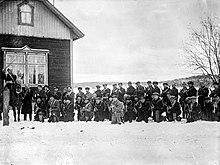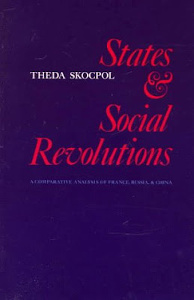
A revolutionary movement (or revolutionary social movement) is a specific type of social movement dedicated to carrying out a revolution.

A revolutionary movement (or revolutionary social movement) is a specific type of social movement dedicated to carrying out a revolution.
Charles Tilly defines it as "a social movement advancing exclusive competing claims to control of the state, or some segment of it". [1] Jeff Goodwin and James M. Jasper define it more simply (and consistently with other works [2] [ need quotation to verify ]) as "a social movement that seeks, as minimum, to overthrow the government or state". [3]
A social movement may want to make various reforms and to gain some control of the state, but as long as they do not aim for an exclusive control, its members are not revolutionary. [4] Social movements may become more radical and revolutionary, or vice versa - revolutionary movements can scale down their demands and agree to share powers with others, becoming a run-of-the-mill political party. [4]
Goodwin distinguishes between a conservative (reformist) and radical revolutionary movements, depending on how much of a change they want to introduce. [4] A conservative or reformist revolutionary movement will want to change fewer elements of the socio-economic and cultural system than a radical reformist movement (Godwin also notes that not all radical movements have to be revolutionary). [4] A radical revolutionary movement will thus want both to take an exclusive control of the state, and to fundamentally transform one or more elements of its society, economy or culture. [4]
An example of a conservative movement would be the American Revolutionary movement of the 18th century, or the Mexican Revolutionary movement of the early 20th century. [4] Examples of radical revolutionary movements include the Bolsheviks in Russia, the Chinese Communist Party and other communist movements in Southeast Asia and in Cuba (which attempted to introduce broad changes to the economic system), the movements of the 1979 Iranian Revolution against the shah, and some[ which? ] Central American guerrilla movements. [5] [6] For a movement to be considered[ by whom? ] revolutionary in the modern-day United States it should call for a change of the dominant economic system (capitalism) or the political system (two-party representative democracy) operating in that society. [6] [ need quotation to verify ]
The same social movement may be viewed differently depending on a given context (usually the government of the country where it unfolds). [7] For example, Jack Goldstone notes that the human rights movement can be seen as a regular social movement in the West, but it is a revolutionary movement under oppressive régimes like that in China. [7] Another example he mentions was the racial equality movement, which could be seen as revolutionary a few decades ago in South Africa, but as of 1998 [update] is just a regular social movement. [7]
A revolutionary movement can be non-violent, although it is less common than not. [6] [8] Revolutionary movements usually have a wider repertoire of contention than non-revolutionary ones. [6]
Five crucial factors to the development and success of a revolutionary movements include: [6]
A Jacobin was a member of the Jacobin Club, a revolutionary political movement that was the most famous political club during the French Revolution (1789–1799). The club got its name from meeting at the Dominican rue Saint-Honoré Monastery of the Jacobins. The Dominicans in France were called Jacobins because their first house in Paris was the Saint Jacques Monastery.
Libertarian socialism is an anti-authoritarian and anti-capitalist political current that emphasises self-governance and workers' self-management. It is contrasted from other forms of socialism by its rejection of state ownership and from other forms of libertarianism by its rejection of private property. Broadly defined, it includes schools of both anarchism and Marxism, as well as other tendencies that oppose the state and capitalism.
In political science, a revolution is a rapid, fundamental transformation of a society's class, state, ethnic or religious structures. According to sociologist Jack Goldstone, all revolutions contain "a common set of elements at their core: (a) efforts to change the political regime that draw on a competing vision of a just order, (b) a notable degree of informal or formal mass mobilization, and (c) efforts to force change through noninstitutionalized actions such as mass demonstrations, protests, strikes, or violence."
Right-wing politics is the range of political ideologies that view certain social orders and hierarchies as inevitable, natural, normal, or desirable, typically supporting this position based on natural law, economics, authority, property, religion, or tradition. Hierarchy and inequality may be seen as natural results of traditional social differences or competition in market economies.

A social movement is a loosely organized effort by a large group of people to achieve a particular goal, typically a social or political one. This may be to carry out a social change, or to resist or undo one. It is a type of group action and may involve individuals, organizations, or both. Social movements have been described as "organizational structures and strategies that may empower oppressed populations to mount effective challenges and resist the more powerful and advantaged elites". They represent a method of social change from the bottom within nations. On the other hand, some social movements do not aim to make society more egalitarian, but to maintain or amplify existing power relationships. For example, scholars have described fascism as a social movement.

Social change is the alteration of the social order of a society which may include changes in social institutions, social behaviours or social relations. Sustained at a larger scale, it may lead to social transformation or societal transformation.
According to different scholars, the history of anarchism either goes back to ancient and prehistoric ideologies and social structures, or begins in the 19th century as a formal movement. As scholars and anarchist philosophers have held a range of views on what anarchism means, it is difficult to outline its history unambiguously. Some feel anarchism is a distinct, well-defined movement stemming from 19th-century class conflict, while others identify anarchist traits long before the earliest civilisations existed.

States and Social Revolutions: A Comparative Analysis of France, Russia and China is a 1979 book by Theda Skocpol, published by Cambridge University Press, that examines the causes of social revolutions.
Contentious politics is the use of disruptive techniques to make a political point, or to change government policy. Examples of such techniques are actions that disturb the normal activities of society such as demonstrations, general strike action, direct action, riot, terrorism, civil disobedience, and even revolution or insurrection. Social movements often engage in contentious politics. The concept distinguishes these forms of contention from the everyday acts of resistance explored by James C. Scott, interstate warfare, and forms of contention employed entirely within institutional settings, such as elections or sports. Historical sociologist Charles Tilly defines contentious politics as "interactions in which actors make claims bearing on someone else's interest, in which governments appear either as targets, initiators of claims, or third parties."

Social movement theory is an interdisciplinary study within the social sciences that generally seeks to explain why social mobilization occurs, the forms under which it manifests, as well as potential social, cultural, political, and economic consequences, such as the creation and functioning of social movements.
Jeffrey Roger Goodwin is a professor of sociology at New York University. He has served as chair of several sections of the American Sociological Association (ASA) and was coeditor of the ASA journal Contexts from 2004 to 2007.
Radical politics denotes the intent to transform or replace the fundamental principles of a society or political system, often through social change, structural change, revolution or radical reform. The process of adopting radical views is termed radicalisation.
Far-left politics, also known as extreme left politics or left-wing extremism, are politics further to the left on the left–right political spectrum than the standard political left. The term does not have a single, coherent definition; some scholars consider it to be the left of communist parties, while others broaden it to include the left of social democracy. In certain instances—especially in the news media—far left has been associated with some forms of authoritarianism, anarchism, communism, and Marxism, or are characterized as groups that advocate for revolutionary socialism and related communist ideologies, or anti-capitalism and anti-globalization. Far-left terrorism consists of extremist, militant, or insurgent groups that attempt to realize their ideals through political violence rather than using democratic processes.

Repertoire of contention refers, in social movement theory, to the set of various protest-related tools and actions available to a movement or related organization in a given time frame. The historian Charles Tilly, who brought the concept into common usage, also referred to the "repertoire of collective action."
No Other Way Out: States and Revolutionary Movements, 1945-1991 is a book written by Jeff Goodwin. It analyzes revolutions through the state-centered perspective.

Activism consists of efforts to promote, impede, direct or intervene in social, political, economic or environmental reform with the desire to make changes in society toward a perceived common good. Forms of activism range from mandate building in a community, petitioning elected officials, running or contributing to a political campaign, preferential patronage of businesses, and demonstrative forms of activism like rallies, street marches, strikes, sit-ins, or hunger strikes.
The Charles Tilly Award for Best Book is given by the Collective Behavior and Social Movements section of the American Sociological Association in recognition of a significant contribution to the field. Nominees of the award are regarded as being representative of the "best new books in the field of social movements." The award was established in 1986, and is named after sociologist Charles Tilly.
The Principlists, also interchangeably known as the Iranian Conservatives and formerly referred to as the Right or Right-wing, are one of two main political camps in post-revolutionary Iran; the Reformists are the other camp. The term hardliners that some western sources use in the Iranian political context usually refers to the faction, although the principlist camp also includes more centrist tendencies. The faction rejects the status quo internationally, but favors domestic preservation.
Politics in the Islamic Republic of Iran are dictated by factionalism. All political parties were banned in the Islamic Republic in 1987. Today, several political factions encapsulate the political landscape in the Persian country, and scholars such as Maziar Behrooz, Behzad Nabavi, Bahman Baktiari, Maaike Warnaar, Payam Mohseni, have given different formulations of them, varying in number and orientation.

Socialism in Italy is a political movement that developed during the Industrial Revolution over a course of 120 years, which came to a head during the Revolutions of 1848. At the beginning of the 20th century, there were a growing number of social changes. The outbreak of the First World War accelerated economic differentiation causing a wider wealth gap. This is seen as one of the key factors that triggered the emergence of Italian socialism.